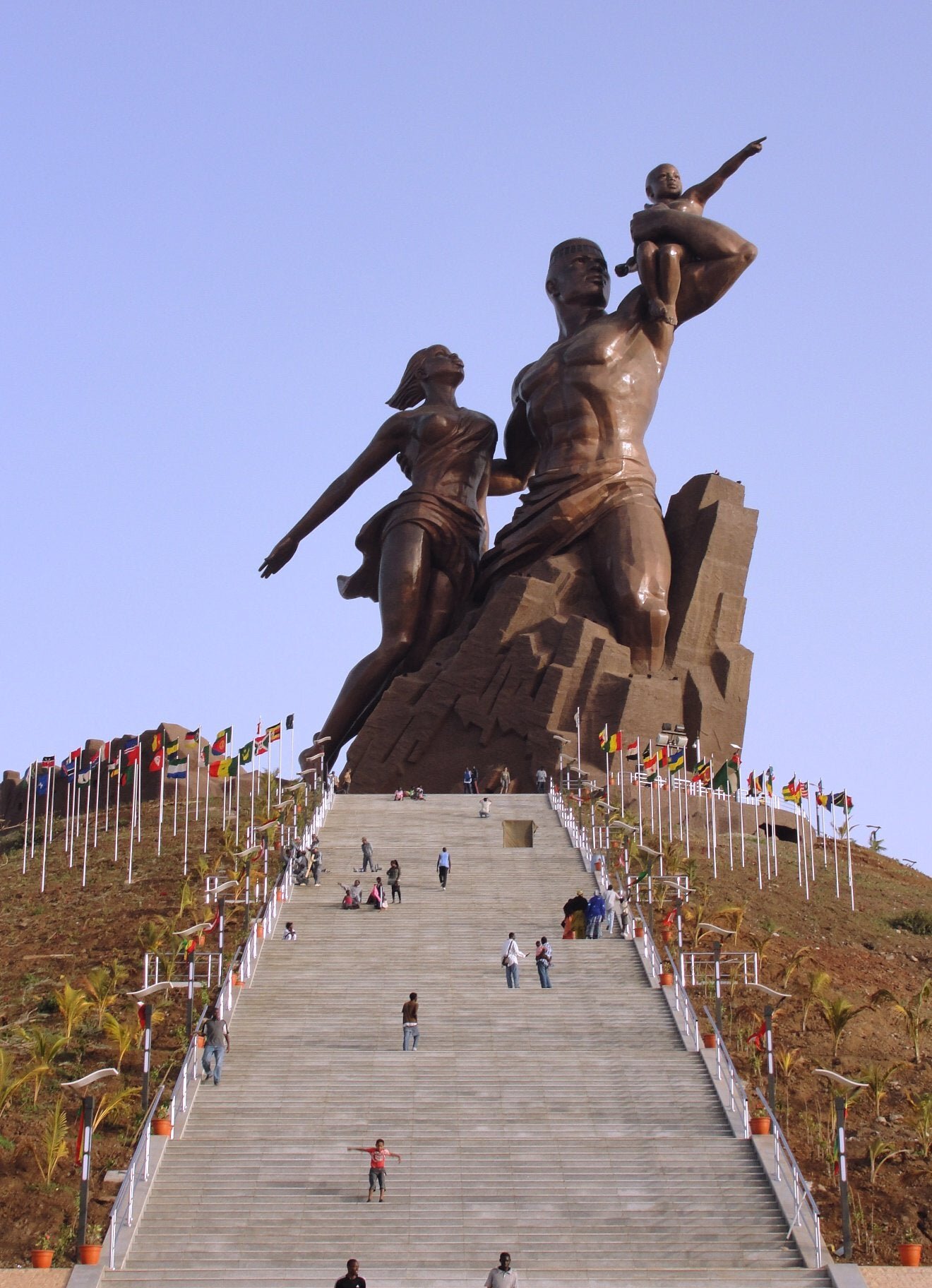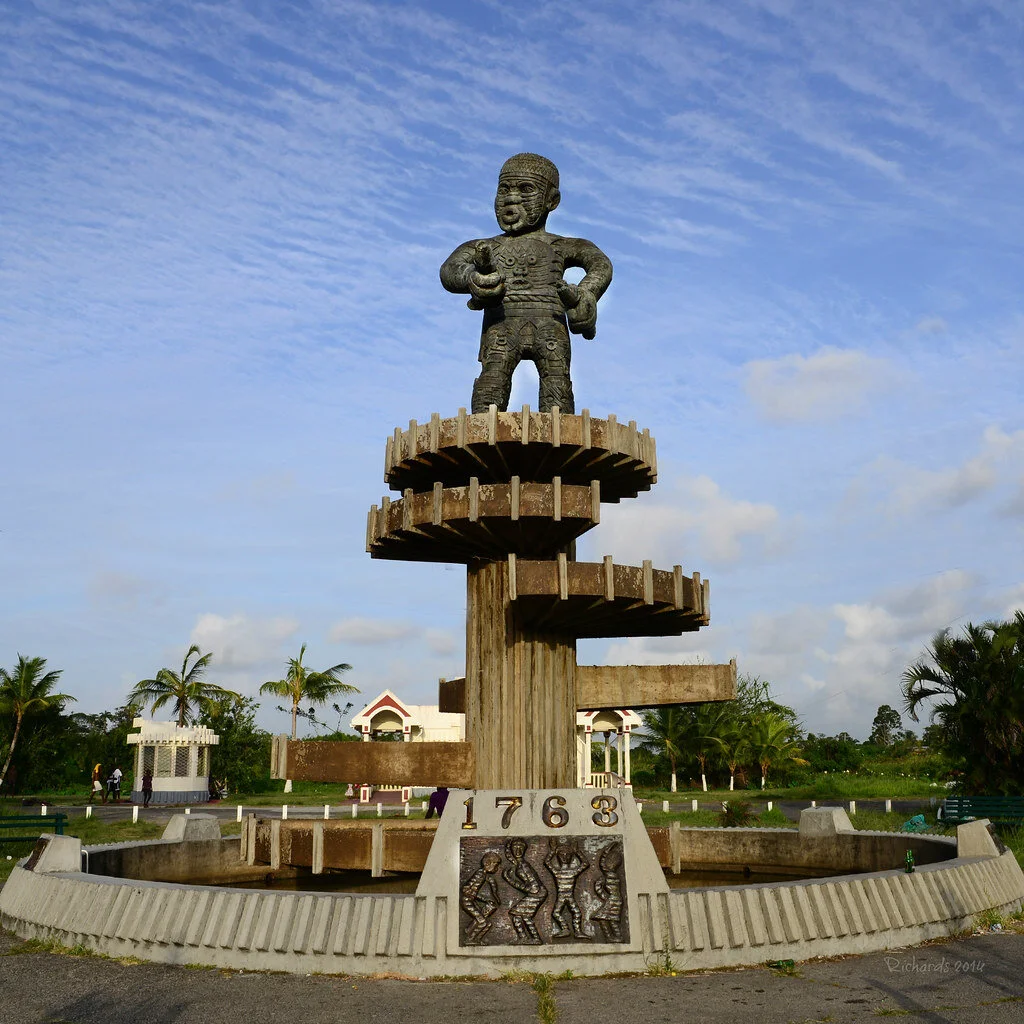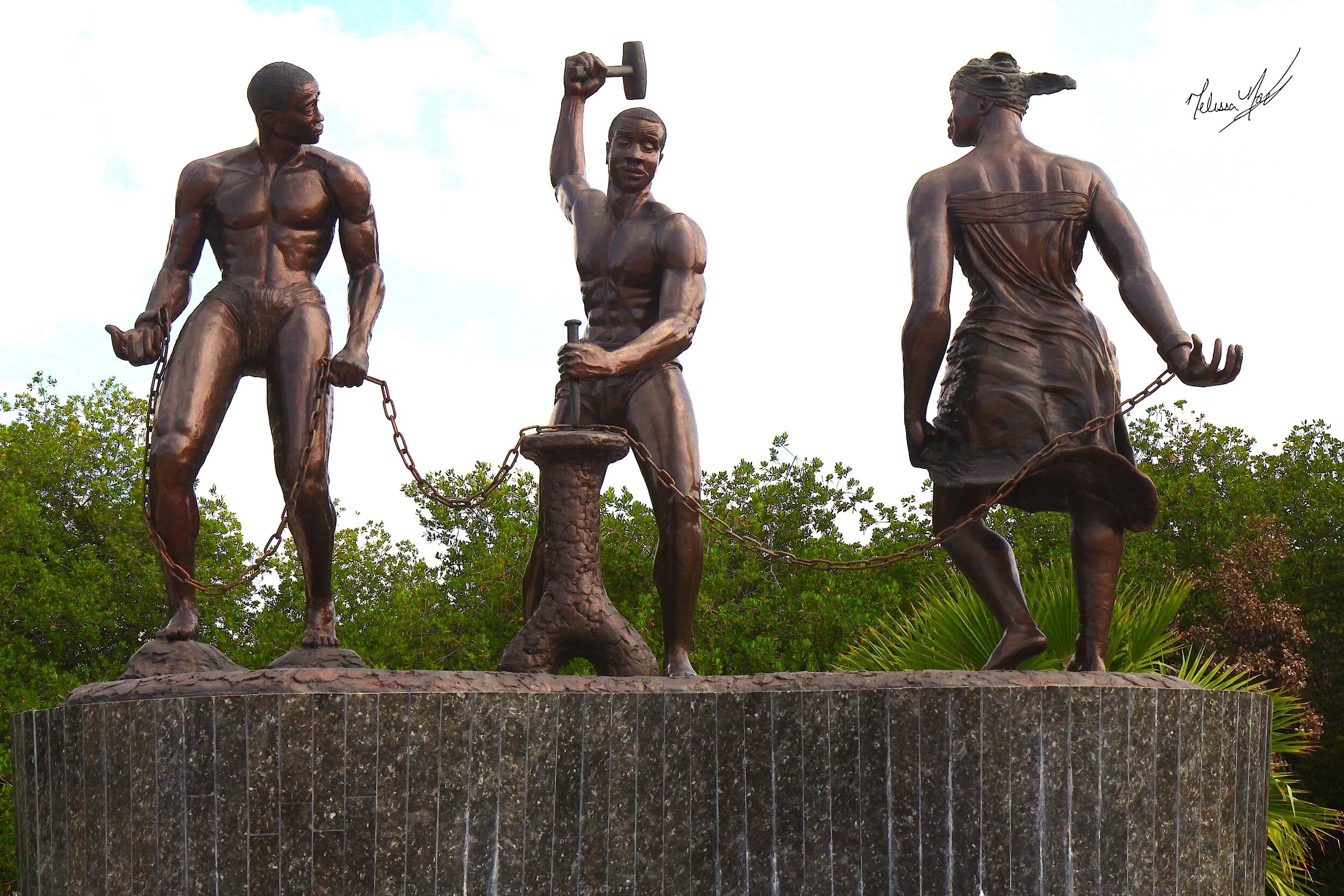seven Black liberation monuments i wish i knew about
Black communities been about that life
Hey y’all! The year is still 2020, and as of writing this post (sometime in June cuz I’ve lost track of time) America is still in the midst of a social rebellion. Not gunna lie, I am pretty anxious about what our social future will look like. Am I optimistic about the government actually providing the racial justice and social equity that Black people deserve? No. Not at all, because Amerikkka will always be Amerikkka. But, I am happy about the momentum that many social movements are gaining in 2020.
From the Occupy Movement, to #BlackLivesMatter, and #MeToo, people have been advocating for better society for decades. We are no longer being faithful to social systems that do not benefit or serve us. We are speaking our truths and forcing others to be held accountable for their actions. We’re done being silent about brutality, transphobia, and racism, because it is literally killing us.
And even though I’m unhappy about the current state of politics and the world, I am happy to see the theories and hard work of so many revolutionaries, activists, and community organizers finally come to light (y’all have worked so long for this). But, best of all, I am ECSTATIC about the internal changes and mindset shifts that 2020 has created, because, we, as a people are DEMANDING justice and are not settling for anything less.
Naturally, I took time to do some internal reflection, and as I sat back and thought about what’s going on in Amerikkka and the world, it prompted me to research past social movements and slave rebellions. And, in doing so, I remembered (and even learned in some cases), that freedom has never been given to a group of people. I mean, can you imagine someone walking up to their oppressor and asking politely to be set free? Nah cuz, that’s not how that works!
Black people, throughout history, have always DEMANDED justice and equality all over the world. We ain’t new to this, we’re true to this
what does this have to do with travel?
I’m getting there fam!
As apart of my research on social movements (shoutout to all of my woke and radical friends), I came across a few monuments around the world that honor Black freedom fighters who led this very same kind of social upheaval that we’re experiencing right now. And honestly, since we’re tearing down statues of confederate leaders who shouldn’t be celebrated, why don’t we replace them with Black heroes who ACTUALLY fought for equality?
So, I went on an internet search (cuz #COVID) to see what else is out there. And I found that there are many monuments that highlight the spirit of rebellion and resiliency of Black people. These monuments reminded me that our ancestors all around the globe organized and DEMANDED justice, and have been publicly acknowledged for doing so (via these monuments). They actually honor the work and courage that Black radicals had in order to change their societies, and don’t just display Black bodies in bondage.
Because I now feel enlightened, and because I want to celebrate Black joy during a pretty emotional time, I decided to dedicate a blog post to monuments that honor the spirit of Black Liberation and recognize how we’ve been able to fight and overcome oppression. Our history is not just our enslavement. It is so much more. So, hopefully you learn something new and can make it a point to visit a few of these spots!
Here is a brief list of Black Liberation Monuments around the globe that you can check out (after COVID).
African Renaissance Monument · Dakar, Senegal
Black & Liberated, Family Edition
Breh, my ignorance was at an all time high when I discovered this! This bronze statue was built in 2006, and debuted to the world in 2010. I guess I’m slow because I didn’t even know something as massive as this statue existed (and, it’s the largest monument in Africa) until 2015, and that was via Instagram. Towering over the Statue of Liberty at 165 feet high, the African Renaissance monument in Senegal pays homage to the liberation of African countries and peoples throughout the world.
Anywho, I’ve heard nothing but great things about Senegal, so I’m super excited to visit Dakar and make a stop to this statue when I get a chance.
Even though this monument looks cool, it apparently has sparked a lot of controversy within the country because of the cost and the depiction of half-naked people in a conservative muslim country. So, don’t be surprised if you see some angry locals and/or trash around this monument.
If you have time in Dakar, make sure to check out the Statue of Liberation on Goree Island too!
La Múlatresse Solide of Guadeloupe · Island of Guadeloupe
Lady Solitude of Guadeloupe
Have you ever seen a statue of a pregnant Black woman? I have not.
But, sis right here is a BOSS! Sadly, much isn’t known about the life of Solitude. But, apparently Solitude is a mixed raced woman from Congo who was born a slave on the Island of Guadeloupe. Her mother was an enslaved African woman, and her father was a European sailor who worked on slave ships that crossed the Middle Passage.
Once she grew up, my girl right here fought against the British and French in the late 1790s to abolish slavery in Guadeloupe. And the rebellion was successful! The local Black community was able to fight against their oppressors. But, after the British complained about losing their “territory” and “property”, the French, by way of Napoleon Bonaparte, intervened to try and recolonize the island in the early 1800s.
Sis was like nah. I’ve had enough! So, while pregnant, Solitude not only fought for, but helped lead the second rebellion against the French because she would rather die than let her unborn child be born into slavery.
we f*cks with you SIS
Sadly, the second Black rebellion against the French was unsuccessful and the island was recolonized. Many of the rebels who fought so bravely were captured and killed despite putting up a hell of a fight. Solitude was captured and gave birth to her unborn child as a prisoner of war, but was killed shortly afterwards. F*ck racism.
I Am A Man Plaza · Memphis, Tennessee
So back in 1968, two sanitation workers, Echol Cole and Robert Walker, were crushed to death by a sh*tty sanitation truck. Because racists ain’t sh*t, the city did nothing to support or even grieve their deaths, which were completely preventable at the time.
Fed up with the bullsh*t, the sanitation workers of Memphis banded together to form a union and protest against the sanitation system for the low wages, unfair and inhumane treatment of Black sanitation workers, and lack of overall safety measures to protect their health and lives.
The union staged a sit in and protested for two months to DEMAND JUSTICE. And, of course the police fought against the nonviolent protestors with tear gas, rubber bullets, and other ruthless tactics. Things got so heated that Dr. Martin Luther King Jr. flew in to Memphis to support the sanitation workers and pressure the city council to stop upholding racism, but they refused. Sadly, Dr. King was assassinated the night after addressing the sanitation workers.
A few weeks after his assassination, roughly 40,000 people descended upon Memphis to protest the injustices, and the city of Memphis gave in to the demands of the protestors. But, at what cost?
Thus, in 2018, the city of Memphis unveiled the I Am A Man Plaza to commemorate the price of justice, or in this case, the lengths at which racists are willing to go to in order to protect their financial interests. The names of each sanitation worker who fought for justice for is engraved on this plaza.
Bussa Emancipation Statue · Bridgetown, Barbados
Bussa fighting for Emancipation
I usually don’t like to highlight statues that focus on slavery or place Black people in bondage, but I f*cks with THIS statue because of Bussa. You see, Bussa was that dude.
Bussa was rumored to have been born a free man in West Africa, but was then captured, sold into slavery, and sent to Barbados.
Having known what freedom was, my mans was like nah fam, we not doing this. He was FED. UP. So, in 1816, he pulled together 400 of his homeboys and was like, we finna tear this shit down.
So, Bussa inspired and led the largest (and only) slave rebellion against the major plant and plantation owners in Barbados, leading to the eventual end of slavery in the country a few decades later.
Apparently this statue is not actually of Bussa because no one knows much about him. But Bajans decided to nickname the statue after him because of how influential he was to Black Liberation and to the country itself.
Cuffy or Kofi · Georgetown, Guyana
Cuffy , Leader of the Berbice Rebellion
Similar to the story above, my guy Cuffy, or Kofi, was born a free man in Ghana, but was then captured and sold into slavery by the Dutch on island of Guyana.
The funny thing about slavery in Guyana in the 1700s is that shit was mad imbalanced. In the city of Berbice, there were only 250 Dutch colonizers/plantation owners, but roughly 4,000 enslaved Africans.
Recognizing that the ratio was in their favor, Kofi organized his brethren into a military unit to pull up on the colonizers and burn that shit to the ground, in what is known as the Berbice Rebellion. He and the other enslaved Africans led several rebellions throughout the years, but the group eventually collapsed due to internal fighting and rifts between Kofi and other leaders of the rebellion.
Slavery wasn’t abolished in Guyana until 1838, but Kofi is still remembered for his efforts with this commemorative statue that stands atop a fountain and reflective pool.
I Am Queen Mary · Copenhagen, Denmark
Queen Mary, Leader of the Fireburn Revolt
I swear I get more and more excited with each landmark! But let’s take time to recognize another great freedom fighter, the Queen Mary Thomas.
Back in 1848, Denmark officially abolished slavery in their territories, one of which was St. Croix. But, instead of making things right or creating some form of equitable system, the Danish and the plantation owners replaced slavery with a form of contractual labor that was basically slavery by another name. The laborers, who were Black folks that were formerly enslaved, made unlivable wages and were indebted to their bosses for life (sound familiar)?
Well, in 1878, Black folks had enough. They staged peaceful protests to demand labor rights. But, after the local police murdered a Black laborer, the protesters fought back to demand justice (sound familiar)? My good sis Queen Mary said (in my Meek Mill voice) Let That Shit Burn. LITERALLY.
So, Queen Mary and her counterparts her counterparts Queen Agnes Salomon, and Queen Mathilda McBean (#BlackGirlMagic) led a rebellion where the other laborers set fire to every plantation on the island and burned over 800 acres worth of land in what is known as the Fireburn Revolt, or the St. Croix labor riots. And y’all were mad about a little Wendy’s or a Target!
The Danish military captured Queen Mary and sentence her to life in prison in Copenhagen. She spent the rest of her life enslaved as a prison laborer in Copenhagen and eventually back in St. Croix, where she died. But her fight to end racism and unjust labor conditions for Black people lives on forever, and is commemorated by this exhibition in Denmark.
And if you’re wondering why her pose looks so familiar, it’s because the two Black female artists who created this sculpture (La Vaughn Belle and Jeannette Ehlers) modeled Queen Mary’s pose after Huey Newton’s famous Black Panther Party shot, which is also the same pose we saw T’Challa make in the movie, Black Panther.
You can also see Queen Mary, Queen Agnes, and Queen Mathilda at the Three Queens Fountain in front of Blackbeard’s Castle on the island of St. Thomas! If you can’t make it to Denmark or St. Thomas, then check out Barnard College in NYC. They are displaying a scaled down version of this same monument on their campus.
Tula Monument · Willemstad, Curaçao
Tula Rigaud Liberating Himself
I thought you didn’t like to show Black people in bondage?
Yes, you’re right. I don’t. But, what if the statue is of someone who not only demanded freedom, but TOOK IT?Because this statue of Tula Rigaud in Curaçao depicts exactly that, a group of enslaved Black people breaking their own bondage and taking back their freedom!
See Tula was an enslaved laborer in Curaçao. One day, he politely asked the plantation owners to reduce labor hours and give laborers the freedom to buy clothes and other goods from wherever they want, and not just from their plantation owners, which was the law at the time. But, of course, the owners said no and ignored his request.
So my mans was like bet. He knew about the successful slave rebellion in Haiti, so he decided to go out and try it. He spent some time planning a rebellion, and after a few weeks, he rallied together the other laborers on his plantation, walked up to the plantation owner and told them mfs that they (the laborers) were all free. BOOM. Just like that, they refused to work or be enslaved any longer. No fighting, no begging, just DEMANDING JUSTICE and walking tf out of there.
After that, Tula went to the local jails and nearby plantations to alert other slaves that they were also now free too, because who are these plantation owners to enslave them? Tf?
This liberation lasted for a month before the colonizers captured Tula and publicly tortured and killed him for leading this rebellion, known as the Curaçao Slave Revolt of 1795. Shortly after Tula’s heinous execution, the Curaçao government developed new regulations for enslaved laborers and plantation owners, which led to more favorable conditions for the laborers, and to the eventual abolition of slavery on the island in 1863.
This statue currently resides in the plaza where Tula was murdered to commemorate his humanitarianism and courage. Shoutout to Tula: #KnowYourWorth and DEMAND Justice.
don’t forget to #travelblack too!
Thank you so much for reading! Now that you know a little bit more about Black liberation around the world, I also want to encourage everyone to try and visit these monuments. And, when you’re planning your vacations or future trips for the year 2024 (because clearly that’s when we’re going to be allowed to travel again lmao) think about visiting countries with strong Black cultures. As people continue to have this racial awakening, and are starting to buy Black and Amplify Black voices, don’t forget to keep that same energy for traveling too! Use your vacations as an opportunity to learn about the Black history that exists in the places that you’re visiting!
sooo, which ones are you adding to the bucket list?
Has anyone been to these monuments? What did you think? If not, which ones are you adding to your bucket list? Am I missing any that you’ve visited? Let me know in the comments below!






